Pothos is an excellent choice for beginners or those who don’t have much experience with plants.
As a gardener myself, I’ve found that pothos is one of the easiest plants to grow indoors. It is, in fact, one of the first plants that I have ever grown indoors.
Pothos is a resilient plant that can thrive in a variety of environments, making it the perfect choice for novice gardeners.
In this guide, I’ll share the ultimate guide to pothos plant, including some tips on how to care for your pothos plant and help it thrive.
What is Pothos?
Pothos is a tropical climbing vine with heart-shaped leaves that has so many varieties and cultivars.
The plant gets its common name, “pothos,” from its first genus, Pothos aureus, which then being reclassified to Epipremnum aureum.
Pothos plant has many different nicknames, including Devil’s Ivy, Money Plant, Devil’s Vine, Ivy Arum, and Taro Vine.
Pothos is a member of the Araceae family, which includes many other popular houseplants like philodendrons, anthuriums, and calatheas.
Pothos plants are a fast-growing, easy-to-care plant that can thrive in a variety of conditions, making them a popular choice for both indoor and outdoor gardens.
The leaves of pothos plants are usually variegated, with shades of green, white, and yellow.
Pothos plants are native to Mo’orea, Society Islands Archipelago, French Polynesia, but as they’re invasive plant, they have been growing rapidly and out of control in many tropical countries, peculiarly in South East Asia.
These beautiful plants can grow quite large, reaching up to 15 feet in length when grown indoors and up to 50 feet when grown outdoors.
While they are typically found in moist, humid environments, pothos plants can also thrive in drier conditions if they are given proper care.
Pothos is also known for its ability to purify the air, making it an ideal choice for indoor spaces.
Popular Varieties of Pothos
Pothos come in many varieties and cultivars, including the standard Golden, Marble Queen, Neon, Manjula, and N’Joy. There are also some variegated types available, such as the Pearls and Jade® pothos.
Golden Pothos (Epipremnum aureum)
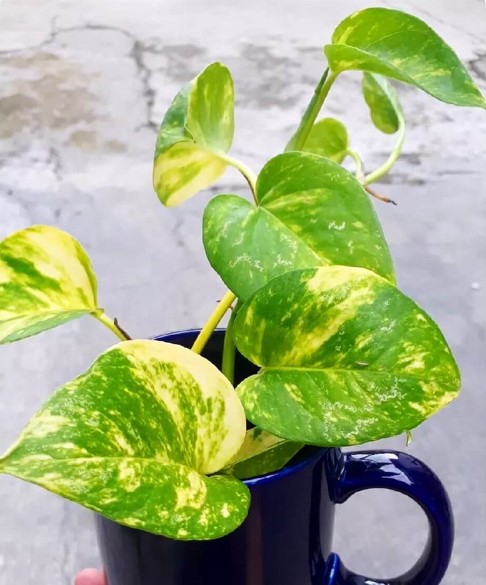
Golden pothos is the most common pothos you’ll find. It is a popular houseplant with glossy, heart-shaped leaves. It has bright green leaves with irregular yellowish-golden flecks.
Marble Queen Pothos (Epipremnum aureum ‘Marble Queen’)
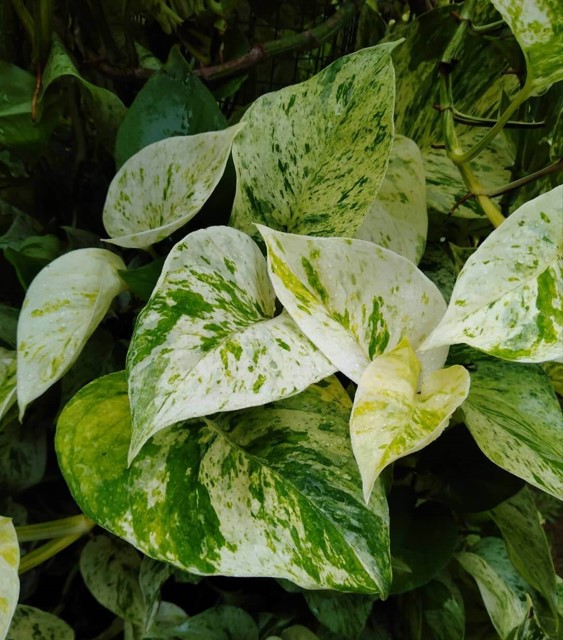
The marble queen pothos is a fast-growing, trailing vine that can reach up to 10 feet in length. It has a mix of green leaves with an inconsistent splash of light green and white that looks like marble.
N’joy Pothos (Epipremnum aureum ‘Njoy’)
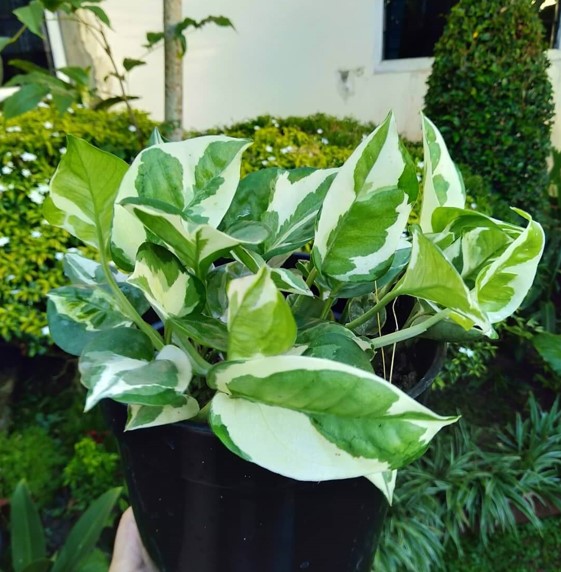
N’joy Pothos is a type of pothos plant that is known for its variegated leaves. The leaves of this plant are usually green with white markings. Unlike marble queen pothos that has splashed pattern, n’joy pothos’ pattern is more solid. They’re usually green in the center with white marks on the outside.
Neon Pothos (Epipremnum aureum ‘Neon’)

Neon pothos is a cultivar of pothos that has bright limegreen or chartreuse in color with no variegation. The young leaves of neon pothos are neon-yellow, but as they grow older it becomes darker.
Jade pothos (Epipremnum aureum ‘Jade’)
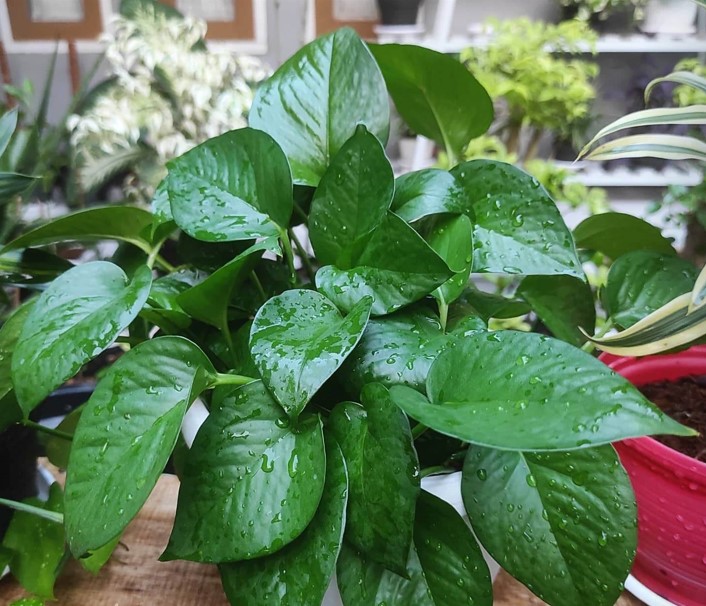
Jade pothos is very similar to golden pothos in terms of leaf shape, growth size, and treatment. But it has completely dark green leaves with no variegation at all. In fact, jade pothos is a naturally mutated variegation of golden pothos.
Manjula Pothos (Epipremnum aureum ‘Manjula’)
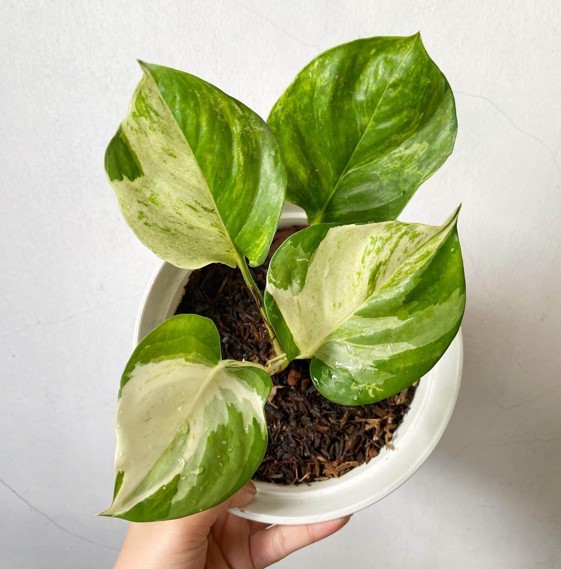
Manjula pothos is a cultivar of pothos that look 90% like marble queen. The only distinction you can tell is from the shape of its leaves – they’re rounder and wider.
How to Grow Pothos
Pothos plants are arguably the easiest houseplant to care for. They can grow in almost any type of lights, soil, and humidity. There’s a reason why this plant got the Devil’s Ivy name.
However, this also become one of the reasons why some plant parents experience problems with their pothos, such as dying, leaves turning yellow, root rot, and others.
Apparently, many people think this plant is literally hard to kill so they forgot to pay attention to them.
In fact, there are only three basic things to understand to grow a healthy and lush pothos: light, water, and soil.
What Lighting Environment Does Pothos Prefer?
Pothos prefers a bright, indirect light. Pothos can also tolerate low light, but will grow slower in these conditions.
If you are growing pothos indoors, near a window is usually a good spot for it. Pothos can also do well under artificial light like fluorescent bulbs.
Non-variegated pothos are more low-light tolerant than the variegated ones.
If you have variegated pothos, you must understand that they lack chlorophyll, and hence, they aren’t able to photosynthesize properly.
So, you will need to help them by giving a higher amount of light to maintain or increase their variegation. At least 10-12 hours a day.
If not, they can revert their leaves back to green. If too much, it might result in leaf burn.
Theoretically, the more variegated your pothos is, the more light it needs.
How Can I Tell if My Pothos Needs Water?
As a rule of thumb, you can usually tell if your pothos need water by checking the soil moisture. If the top inch of soil feels dry, then it’s time to water your plant.
But, here’s the thing.
Pothos are very forgiving when it comes to watering. They can withstand underwatering, but not overwatering.
Just like many houseplants, overwatering will result to root rot, and it is hard to recover from it.
To avoid overwatering, never give your pothos too much water and always give them a good drainage potting mix.
I have made a guide to watering pothos, including how can you tell by the signs, read more here.
How Often Do I Need to Water My Pothos?
Pothos are not heavy feeders, so you don’t need to water them very often. I like to water my pothos about once a week, or when the top inch of soil feels dry.
What Type of Soil is Best for Pothos?
Pothos will grow ideally on a well-draining potting mix with neutral pH ranging from 6.1 to 7.
You can use a potting mix that is made for tropical plants. Any brand is ok.
Additionally, you can also add some perlite, lava rocks, or vermiculite to the potting mix to help with drainage.
However, pothos are generally not picky when it comes to soil preference. You can usually use the soil that comes with the pot from store you bought it.
Just make sure the soil is not extremely root bound or contain pests on it.
It is not necessary to repot your pothos unless the roots are visible through the draining hole, having a root bound, or showing a sign of poor health.
Does Pothos Need Fertilizer?
Pothos plants are generally quite low-maintenance, but they will benefit from being fertilized regularly during the growing season.
A slow-release fertilizer or liquid fertilizer diluted to half-strength is a good option.
Most houseplants only need a fertilizer with a 3-1-2 NPK ratio. Fertilizing pothos plants is best done in early spring and summer.
Be sure to follow the directions on the fertilizer packaging, as too much fertilizer can burn the roots of the plant.
Does Pothos Need Humidity?
Pothos plants are tropical plants, so they prefer warm temperatures and high humidity.
The ideal temperature range for pothos plants is 70F-90F, and the ideal humidity level is around 40-60%.
If you can provide these conditions for your pothos plant, it will thrive!
They will tolerate lower humidity levels, but may experience some leaf drop.
If you live in an area with lower humidity levels, you can increase the humidity around your pothos plant by placing it on a pebble tray or by using a humidifier.
How Fast Do Pothos Grow?
They’re fast growing plants! Pothos can grow up to 12-24 inches per month in favorable climate, but they can also slow down or even stop growing if they’re not getting enough light.
To make your pothos grow as fast as possible, you should place it in a brightly lit spot where it will get at least four hours of indirect sunlight each day.
Pothos Propagation
There are a number of reasons why plant parents should learn to propagate pothos.
First, it will make pothos plants grow lush and healthy.
Second, it is one of the way to duplicate your pothos for free.
Third, because it is fun!
Jokes aside, pothos are categorized as invasive plant because they are so easy to propagate that you can even do it unintentionally.
What you’ll need
- A healthy plant of pothos
- A glass container (preferably dark color)
- A cutter (a sharp one)
- A new pot with propagating mix / potting mix
Propagating pothos in water
Advisedly, it’s best not to propagate pothos directly to soil.
Instead, it’s better and easier if you take a cutting from the plant and then root it in water.
Once the cutting has developed the secondary roots, you can then transplant it into soil.
To do this, simply fill a pot with moistened potting mix and insert the cutting.
Firm the mix around the cutting and water well. Keep the soil moist but not soggy, and within a few weeks, you should see new growth appearing.
Can Pothos Grow in Water?
Do you want to grow pothos in water instead of soil? Yes it can. Pothos can live in water as well as growing them in soil. Here’s how to do it:
First, make a cutting of two nodes with one leaf or three nodes with two leaves.
Second, place the cutting in a dark glass container. Avoid clear glass container as roots are easier to grow in low-light condition.
Third, change the water frequently and keep it in a warm place. Avoid placing it in windowsill when it’s cold. The ideal temperature is above 68F to stimulate root growth.
Finally, when the roots have grown, you need to change the water regularly to maintain the oxygen level. The smaller your container, the more frequent you need to do water change.
You can’t move your pothos to soil when it’s already in water for a long time because it has developed water roots that have different purpose than the soil roots. Hence it will be hard to survive in soil.
Pest and Disease Problems with Pothos
Pothos are relatively resistant to pests and diseases. However, they can be susceptible to mealybugs, spider mites, and scale.
If you see any of these pests on your pothos plant, you should take immediate action to remove them.
Spider Mites
Spider mites are a common problem for pothos plants. These tiny pests can cause serious damage to your plant, and they’re difficult to get rid of once they’ve infested a pothos.
The best way to deal with spider mites is to prevent them from getting into your plant in the first place. But if your pothos are already infected, you can apply insecticidal soap on the leaves using cotton swab, or if you have a extremely damaged leaves, you can prune them little by little.
Mealybugs
Mealybugs are one of the most common pests that can attack pothos plants. They are small, sap-sucking insects that congregate in groups and secrete a waxy substance over their bodies. Mealybugs can weaken and even kill pothos plants if left unchecked.
The best way to deal with mealybugs is to remove them by hand using a cotton swab or Q-tip dipped in rubbing alcohol. You can also use a handheld vacuum cleaner to suck them up. If you have a severe infestation, you may need to treat your plant with an insecticide.
Whitefly
There are a few things you can do to deal with whitefly in pothos.
First, make sure to keep your plant healthy and free from stress. If the plant is stressed, it will be more susceptible to problems like whitefly.
Second, keep the area around the plant clean and free of debris. This will help prevent the whiteflies from being able to lay their eggs on your plant.
Finally, you can try using some type of insecticide or soap spray on the plants to help kill the whiteflies.
Fungus Gnats
Fungus gnats can be a real nuisance in the garden, and they can be particularly troublesome when it comes to pothos plants.
These little flies are attracted to the moisture that is often found in potting soil, and they can quickly cause extensive damage to tender young plants.
The best way to deal with fungus gnats is to take steps to keep the soil as dry as possible. You can do this by watering your plants only when necessary and making sure that the soil is well drained.
You can also use a soil-drying agent like perlite or sand to help keep things dry.
If you do notice any signs of fungus gnats, you can kill them off with an insecticide spray.
Root Rot
Root rot is caused by a number of different things, but the most common cause is too much water. When the roots are constantly wet, they can’t get enough oxygen and they start to rot.
The best way to deal with root rot is to make sure that you’re watering your plants correctly.
Make sure the soil is dry before you water it again, and don’t water it if it’s raining. You may also want to try adding some sand or perlite to the potting soil to help it drain better.
If your plant starts showing signs of root rot, you can try repotting it in fresh soil and making sure it gets plenty of air circulation.
Blight
Blight is a fungus that can rapidly kill plants. It’s most commonly seen in pothos, but can also affect other types of plants.
The best way to deal with blight is to catch it early and remove any infected leaves immediately.
You can also try spraying the plant with a fungicide, but it’s important to follow the directions carefully so you don’t harm the plant.
Finally, keep your plant in a well-lit area and water it regularly; blight thrives in moist environments.
Bacterial Wilt
Bacterial wilt can be a difficult disease to deal with, but there are a few things you can do to help your pothos plants recover.
First, try to prune any affected leaves from the plant. Remember not to prune too much leaves at once.
Next, water your pothos plants and fertilize them to help them stay healthy.
Finally, try using a fungicide or bactericide on your plants to help control the spread of the disease.
Yellow Leaves
The most common reasons for pothos leaves turning yellow are watering issue, pest infection, or too much direct sunlight. Another possibility is that the plant is just at the end of its life cycle.
If the leaves are turning yellow because of watering issue, whether it is overwatering or underwatering, you’ll need to cut back on how often you water the plant. Wait until the top inch of soil is dry before watering again.
If the leaves are turning yellow because of a lack of fertilizer, you can remedy this by adding a liquid houseplant fertilizer to the water once a week.
If the leaves are turning yellow because of too much light, move the pot to a location where it will receive less light.
Sometimes, it is just a natural life cycle of a leaf. If the leaf is located near the base and there’s no sign of pest, it’s probably it.
